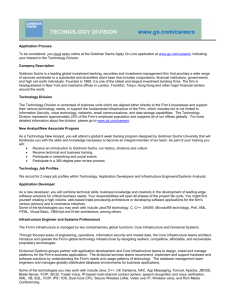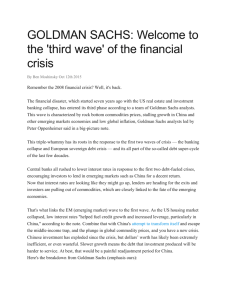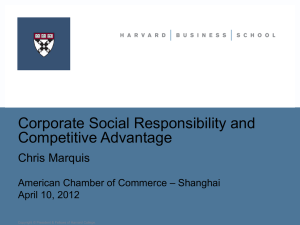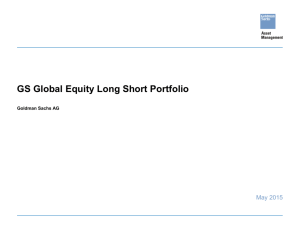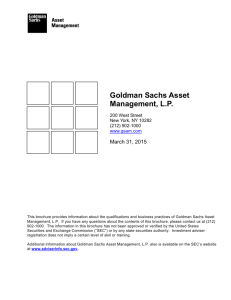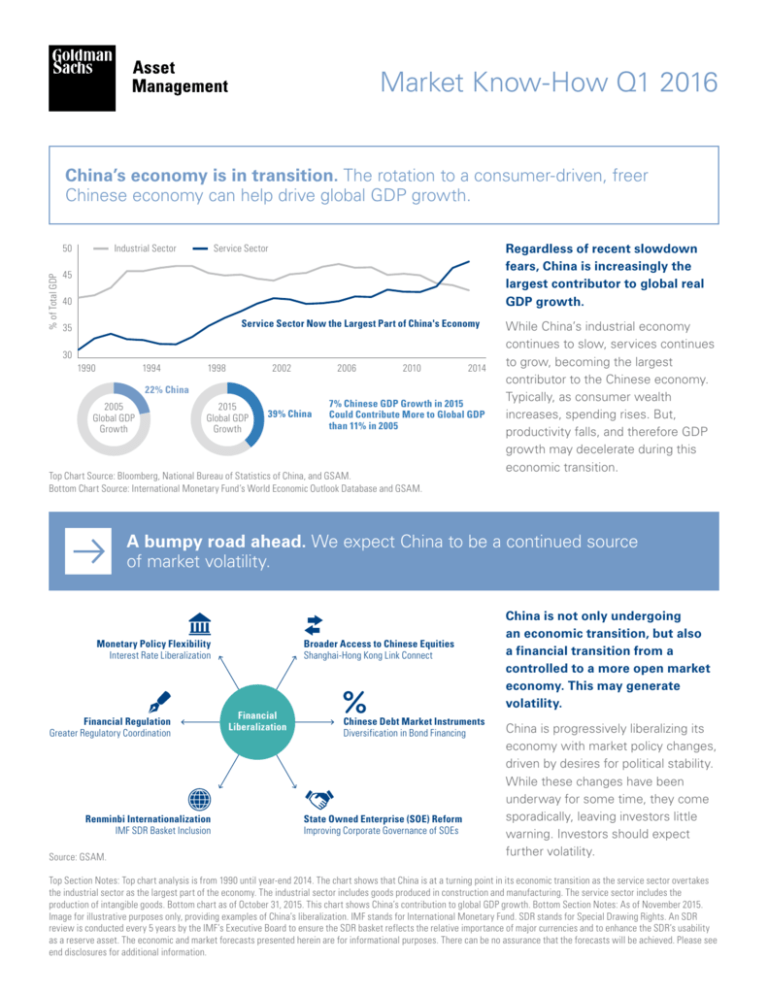
Market Know-How Q1 2016
China’s economy is in transition. The rotation to a consumer-driven, freer
Chinese economy can help drive global GDP growth.
% of Total GDP
50
Industrial Sector
Regardless of recent slowdown
fears, China is increasingly the
largest contributor to global real
GDP growth.
Service Sector
45
40
Service Sector Now the Largest Part of China's Economy
35
30
1990
1994
1998
2002
2006
2010
2014
22% China
2005
Global GDP
Growth
2015
Global GDP
Growth
39% China
7% Chinese GDP Growth in 2015
Could Contribute More to Global GDP
than 11% in 2005
Top Chart Source: Bloomberg, National Bureau of Statistics of China, and GSAM.
Bottom Chart Source: International Monetary Fund’s World Economic Outlook Database and GSAM.
While China’s industrial economy
continues to slow, services continues
to grow, becoming the largest
contributor to the Chinese economy.
Typically, as consumer wealth
increases, spending rises. But,
productivity falls, and therefore GDP
growth may decelerate during this
economic transition.
A bumpy road ahead. We expect China to be a continued source
of market volatility.
Monetary Policy Flexibility
Interest Rate Liberalization
Financial Regulation
Greater Regulatory Coordination
Renminbi Internationalization
IMF SDR Basket Inclusion
Source: GSAM.
Broader Access to Chinese Equities
Shanghai-Hong Kong Link Connect
Financial
Liberalization
Chinese Debt Market Instruments
Diversification in Bond Financing
State Owned Enterprise (SOE) Reform
Improving Corporate Governance of SOEs
China is not only undergoing
an economic transition, but also
a financial transition from a
controlled to a more open market
economy. This may generate
volatility.
China is progressively liberalizing its
economy with market policy changes,
driven by desires for political stability.
While these changes have been
underway for some time, they come
sporadically, leaving investors little
warning. Investors should expect
further volatility.
Top Section Notes: Top chart analysis is from 1990 until year-end 2014. The chart shows that China is at a turning point in its economic transition as the service sector overtakes
the industrial sector as the largest part of the economy. The industrial sector includes goods produced in construction and manufacturing. The service sector includes the
production of intangible goods. Bottom chart as of October 31, 2015. This chart shows China’s contribution to global GDP growth. Bottom Section Notes: As of November 2015.
Image for illustrative purposes only, providing examples of China’s liberalization. IMF stands for International Monetary Fund. SDR stands for Special Drawing Rights. An SDR
review is conducted every 5 years by the IMF’s Executive Board to ensure the SDR basket reflects the relative importance of major currencies and to enhance the SDR’s usability
as a reserve asset. The economic and market forecasts presented herein are for informational purposes. There can be no assurance that the forecasts will be achieved. Please see
end disclosures for additional information.
Risk Disclosures
Confidentiality
There may be additional risks that the Funds do not currently foresee or consider
material. The opinions expressed in this research paper are those of the authors, and
not necessarily of GSAM. The investments and returns discussed in this paper do not
represent any Goldman Sachs product.
No part of this material may, without GSAM’s prior written consent, be (i) copied,
photocopied or duplicated in any form, by any means, or (ii) distributed to any person
that is not an employee, officer, director, or authorized agent of the recipient.
This research paper makes no implied or express recommendations concerning
how a client’s account should be managed. This research paper is not intended to
be used as a general guide to investing or as a source of any specific investment
recommendations.
Views and opinions expressed are for informational purposes only and do not
constitute a recommendation by GSAM to buy, sell, or hold any security. Views and
opinions are current as of the date of this presentation and may be subject to change,
they should not be construed as investment advice.
General Disclosures
This information discusses general market activity, industry or sector trends, or other
broad-based economic, market or political conditions and should not be construed
as research or investment advice. This material has been prepared by GSAM and is
not financial research nor a product of Goldman Sachs Global Investment Research
(GIR). It was not prepared in compliance with applicable provisions of law designed
to promote the independence of financial analysis and is not subject to a prohibition
on trading following the distribution of financial research. The views and opinions
expressed may differ from those of Goldman Sachs Global Investment Research or
other departments or divisions of Goldman Sachs and its affiliates. Investors are
urged to consult with their financial advisors before buying or selling any securities.
This information may not be current and GSAM has no obligation to provide any
updates or changes.
Economic and market forecasts presented herein reflect a series of assumptions
and judgments as of the date of this presentation and are subject to change without
notice. These forecasts do not take into account the specific investment objectives,
restrictions, tax and financial situation or other needs of any specific client. Actual
data will vary and may not be reflected here. These forecasts are subject to high
levels of uncertainty that may affect actual performance. Accordingly, these forecasts
should be viewed as merely representative of a broad range of possible outcomes.
These forecasts are estimated, based on assumptions, and are subject to significant
revision and may change materially as economic and market conditions change.
Goldman Sachs has no obligation to provide updates or changes to these forecasts.
Case studies and examples are for illustrative purposes only.
Although certain information has been obtained from sources believed to be reliable,
we do not guarantee its accuracy, completeness or fairness. We have relied upon
and assumed without independent verification, the accuracy and completeness of all
information available from public sources.
Views and opinions expressed are for informational purposes only and do not
constitute a recommendation by GSAM to buy, sell, or hold any security. Views and
opinions are current as of the date of this presentation and may be subject to change,
they should not be construed as investment advice.
This material is provided for informational purposes only and should not be construed
as investment advice or an offer or solicitation to buy or sell securities.
Past performance does not guarantee future results, which may vary. The
value of investments and the income derived from investments will fluctuate
and can go down as well as up. A loss of principal may occur.
United Kingdom and European Economic Area (EEA): In the United Kingdom,
this material is a financial promotion and has been approved by Goldman Sachs Asset
Management International, which is authorized and regulated in the United Kingdom
by the Financial Conduct Authority.
Index Benchmarks
Indices are unmanaged. The figures for the index reflect the reinvestment of all
income or dividends, as applicable, but do not reflect the deduction of any fees or
expenses which would reduce returns. Investors cannot invest directly in indices.
The indices referenced herein have been selected because they are well known,
easily recognized by investors, and reflect those indices that the Investment Manager
believes, in part based on industry practice, provide a suitable benchmark against
which to evaluate the investment or broader market described herein.
Goldman, Sachs & Co., member FINRA.
© 2016 Goldman Sachs. All rights reserved.
Date of first use: 1/4/2016. Compliance Code 26101-OTU-135350.


